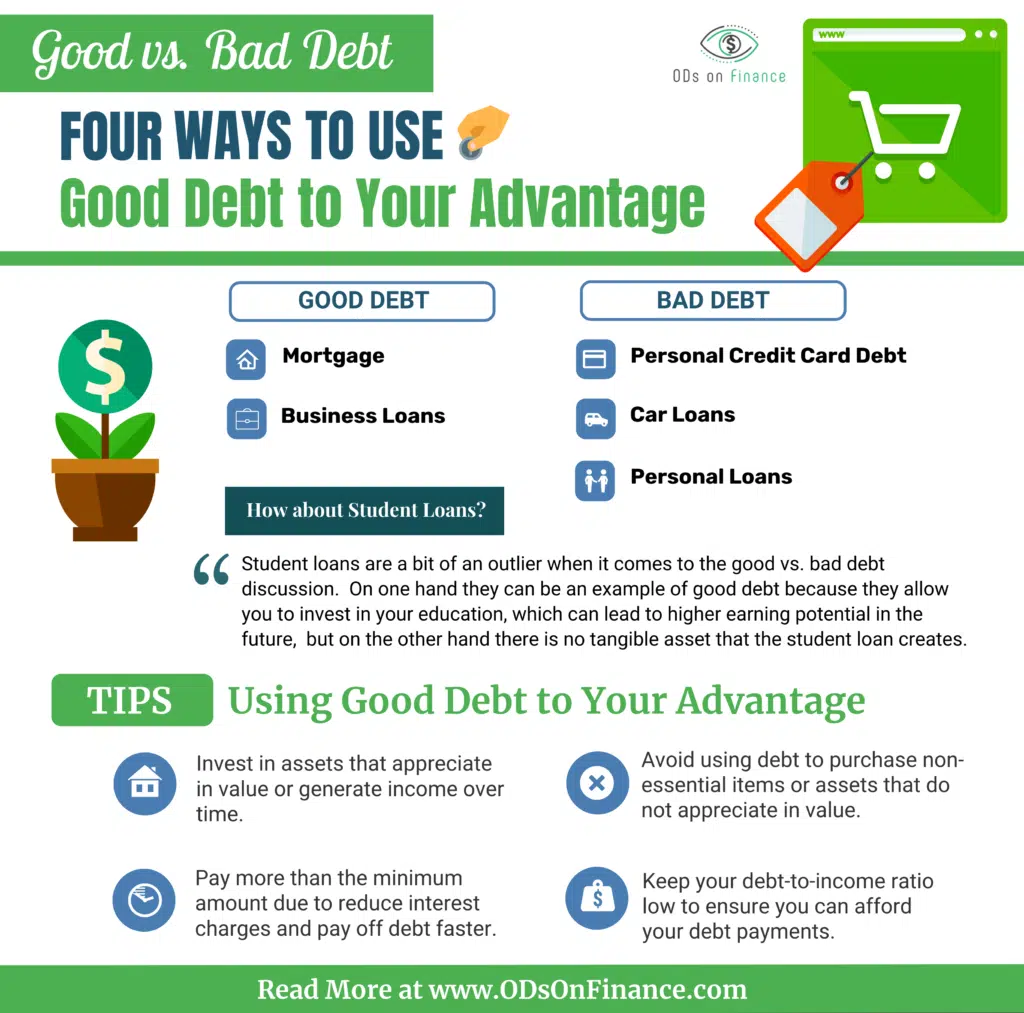Good vs. Bad Optometry Debt – 4 Ways to Use Good Debt to Your Advantage

KEY POINTS:
-
Low debt to debt-free lifestyles are encouraged for financial freedom.
-
Good debt is used to invest in assets that appreciate in value or generate income over time, such as a mortgage or business loan.
-
Bad debt is used to purchase assets that do not appreciate in value or generate income, such as personal credit card debt or personal loans.
-
Student loans are an outlier because they can be good debt as they invest in education, but do not create a tangible asset.
-
Taking out a business loan to fund an optometry office's expansion is a good debt because it can help generate more revenue and improve profitability, such as by adding new equipment or hiring more staff. A business loan can offer flexible repayment terms and tax benefits, but careful planning and consideration are necessary to ensure that it is manageable and within budget.
If you’ve followed ODs on Finance for any amount of time, you’ve probably realized that we are proponents of low debt to debt free lifestyles in order to achieve financial freedom.
That being said, debt can be a useful tool for achieving financial goals, but not all debt is created equal. Some debt can be beneficial, while others can be detrimental to your financial well-being. Let’s explore the difference between good debt and bad debt and how you can use debt to your advantage.
Good Debt
Good debt is debt that is used to purchase assets that appreciate in value or generate income over time. Examples of good debt include:
- Mortgage: A mortgage is a type of loan used to purchase a home. While a mortgage involves borrowing a significant amount of money, it is considered good debt because it allows you to build equity in a valuable asset over time.
- Business Loans: Business loans can be considered good debt if they are used to start or expand a business that generates income over time.
The key to good debt is that it allows you to invest in assets or opportunities that have the potential to appreciate in value or generate income over time.
Bad Debt
Bad debt, on the other hand, is debt that is used to purchase assets that depreciate in value or do not generate income. Examples of bad debt include:
- Personal Credit Card Debt: Personal credit card debt is considered bad debt because it is often used to purchase consumer goods that do not appreciate in value or generate income. Credit card debt typically comes with high-interest rates, which can make it difficult to pay off over time.
- Car Loans: Car loans can be considered bad debt if they are used to purchase a car that depreciates in value over time. While cars are necessary for many people, they are not an investment that appreciates in value.
- Personal Loans: Personal loans can be considered bad debt if they are used for non-essential purchases, such as vacations or entertainment.
The key to bad debt is that it is used to purchase assets that do not appreciate in value or generate income over time, and can often come with high-interest rates that make it difficult to pay off.
Student Loan Debt - Good or Bad?
"Student loans are a bit of an outlier when it comes to the good vs. bad debt discussion. On one hand they can be an example of good debt because they allow you to invest in your education, which can lead to higher earning potential in the future, but on the other hand there is no tangible asset that the student loan creates."
Using Good Debt to Your Advantage
While bad debt can be harmful to your financial well-being, good debt can be used to your advantage. Here are some tips for using debt to your advantage:
4 Tips To Use Debt Effectively
- Use debt to invest in assets that appreciate in value or generate income over time.
- Avoid using debt to purchase non-essential items or assets that do not appreciate in value.
- Always pay more than the minimum amount due to reduce interest charges and pay off debt faster.
- Keep your debt-to-income ratio low to ensure you can afford your debt payments.
One example of good debt used to fund an optometry office's expansion is a business loan. Suppose an optometry office has been experiencing steady growth and wants to expand its services, such as adding new equipment, hiring more staff, or renovating the office space. In that case, a business loan can be a useful tool to finance this expansion.
Taking out a business loan to fund an optometry office's expansion is an example of good debt because it can help the practice generate more revenue and improve profitability.
For example, adding new equipment (like taking advantage of our industry best deals on Optomap or iLight IPL Pro) to the practice can allow for the provision of more comprehensive eye exams, while hiring more staff can increase the number of patients seen per day, thus increasing revenue. A renovated office space can also enhance the patient experience and attract new patients to the practice.
Additionally, a business loan can offer flexible repayment terms that are tailored to the practice's specific needs. For example, a practice can choose a loan term that matches the expected revenue growth from the expansion, allowing them to make timely payments without negatively impacting their cash flow.
Furthermore, taking out a business loan to fund an optometry office's expansion can also be tax-deductible, providing additional financial benefits. The interest paid on the loan can be deducted from the practice's taxable income, resulting in tax savings.
However, it is essential to note that taking out a business loan requires careful planning and consideration. It is essential to ensure that the loan amount, repayment terms, and interest rates are manageable and within the practice's budget.
Even more vital, is having a vetted company experienced in getting optometrists the best loans for their practices, equipment and real estate.
That is why we are proud to partner with Michael Smith and Bank of America, who we are happy to report, has helped over 150+ optometry practices since we started our partnership last year!
Conclusion
In conclusion, both good and bad debt exist and will become a part of an optometrist’s life at some point. The key to financial freedom is simple. Utilize good debt strategically and keep bad debt at a minimum.
Want to get the lowest pricing/promo? Check out Recommended Equipment Partners
Want to get the best business financing? Check out Bank Of America Optometry Doctor Financing Program


Facebook Comments